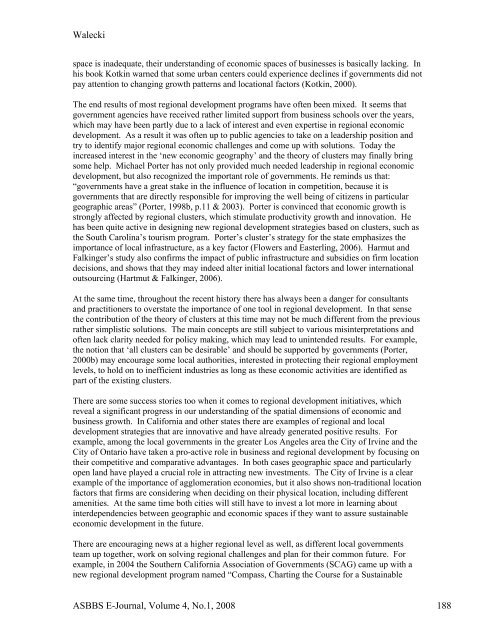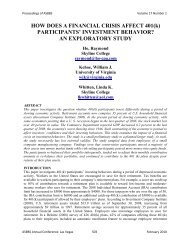stock repurchase announcements: a test of market ... - Asbbs.org
stock repurchase announcements: a test of market ... - Asbbs.org
stock repurchase announcements: a test of market ... - Asbbs.org
You also want an ePaper? Increase the reach of your titles
YUMPU automatically turns print PDFs into web optimized ePapers that Google loves.
Walecki<br />
space is inadequate, their understanding <strong>of</strong> economic spaces <strong>of</strong> businesses is basically lacking. In<br />
his book Kotkin warned that some urban centers could experience declines if governments did not<br />
pay attention to changing growth patterns and locational factors (Kotkin, 2000).<br />
The end results <strong>of</strong> most regional development programs have <strong>of</strong>ten been mixed. It seems that<br />
government agencies have received rather limited support from business schools over the years,<br />
which may have been partly due to a lack <strong>of</strong> interest and even expertise in regional economic<br />
development. As a result it was <strong>of</strong>ten up to public agencies to take on a leadership position and<br />
try to identify major regional economic challenges and come up with solutions. Today the<br />
increased interest in the ‘new economic geography’ and the theory <strong>of</strong> clusters may finally bring<br />
some help. Michael Porter has not only provided much needed leadership in regional economic<br />
development, but also recognized the important role <strong>of</strong> governments. He reminds us that:<br />
“governments have a great stake in the influence <strong>of</strong> location in competition, because it is<br />
governments that are directly responsible for improving the well being <strong>of</strong> citizens in particular<br />
geographic areas” (Porter, 1998b, p.11 & 2003). Porter is convinced that economic growth is<br />
strongly affected by regional clusters, which stimulate productivity growth and innovation. He<br />
has been quite active in designing new regional development strategies based on clusters, such as<br />
the South Carolina’s tourism program. Porter’s cluster’s strategy for the state emphasizes the<br />
importance <strong>of</strong> local infrastructure, as a key factor (Flowers and Easterling, 2006). Harmut and<br />
Falkinger’s study also confirms the impact <strong>of</strong> public infrastructure and subsidies on firm location<br />
decisions, and shows that they may indeed alter initial locational factors and lower international<br />
outsourcing (Hartmut & Falkinger, 2006).<br />
At the same time, throughout the recent history there has always been a danger for consultants<br />
and practitioners to overstate the importance <strong>of</strong> one tool in regional development. In that sense<br />
the contribution <strong>of</strong> the theory <strong>of</strong> clusters at this time may not be much different from the previous<br />
rather simplistic solutions. The main concepts are still subject to various misinterpretations and<br />
<strong>of</strong>ten lack clarity needed for policy making, which may lead to unintended results. For example,<br />
the notion that ‘all clusters can be desirable’ and should be supported by governments (Porter,<br />
2000b) may encourage some local authorities, interested in protecting their regional employment<br />
levels, to hold on to inefficient industries as long as these economic activities are identified as<br />
part <strong>of</strong> the existing clusters.<br />
There are some success stories too when it comes to regional development initiatives, which<br />
reveal a significant progress in our understanding <strong>of</strong> the spatial dimensions <strong>of</strong> economic and<br />
business growth. In California and other states there are examples <strong>of</strong> regional and local<br />
development strategies that are innovative and have already generated positive results. For<br />
example, among the local governments in the greater Los Angeles area the City <strong>of</strong> Irvine and the<br />
City <strong>of</strong> Ontario have taken a pro-active role in business and regional development by focusing on<br />
their competitive and comparative advantages. In both cases geographic space and particularly<br />
open land have played a crucial role in attracting new investments. The City <strong>of</strong> Irvine is a clear<br />
example <strong>of</strong> the importance <strong>of</strong> agglomeration economies, but it also shows non-traditional location<br />
factors that firms are considering when deciding on their physical location, including different<br />
amenities. At the same time both cities will still have to invest a lot more in learning about<br />
interdependencies between geographic and economic spaces if they want to assure sustainable<br />
economic development in the future.<br />
There are encouraging news at a higher regional level as well, as different local governments<br />
team up together, work on solving regional challenges and plan for their common future. For<br />
example, in 2004 the Southern California Association <strong>of</strong> Governments (SCAG) came up with a<br />
new regional development program named “Compass, Charting the Course for a Sustainable<br />
ASBBS E-Journal, Volume 4, No.1, 2008 188

















